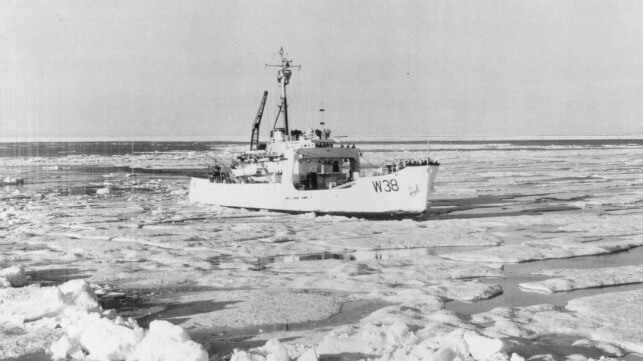The First American Transit of the Northwest Passage

Four hundred and sixty years. That was the span of time that separated the first attempt, in 1497, to discover and navigate a new northerly sea route to East Asia, and the successful attempt in 1957 of three U.S. Coast Guard cutters to break through and officially chart what had become known as the fabled Northwest Passage.
Sailing out of Bristol, England, in May 1497, under the anglicized name of John Cabot, Genoese maritime explorer Giovanni Caboto made the first voyage to the new world to try his luck discovering a faster, more direct trade route to the Far East. Had he been successful, the route would have traversed through the treacherous and complicated archipelago of the Canadian arctic — an immense area of water, ice, and mostly uninhabited snow and ice-covered islands.
Despite his intentions, John Cabot’s voyage ended along the coastline of eastern Canada and possibly Maine. He returned to England and eventually disappeared from history. However, over the next four centuries numerous mariners, explorers, and scientists were inspired to undertake similar voyages experimenting with different routes and charting pathways through the North Polar Region. Indeed, finding a route through the waters of the Northwest Passage became an obsession for several expeditions — many vanishing without a trace or returning home empty-handed. This quest continued unabated up to the 20th century with disappointing results compared to the efforts made.
The first successful attempt to sail through the Passage was accomplished between 1903 and 1905 by Norwegian explorer Roald Amundsen. Using a small, shallow draft fishing vessel, he carefully maneuvered his way through the ice, sticking close to coastlines. The next successful transit of the Northwest Passage was accomplished between the years 1940 and 1942 by a Canadian ship called the St. Roch, which had an ice strengthened hull.
In the summer of 1957, the Northwest Passage was conquered again and charted by three Coast Guard Cutters — Storis (WAG 38), Spar (WAGL 403) and Bramble (WAGL 392). For this journey, the vessels were tasked with establishing and charting a successful path through the Northwest Passage in response to defense concerns caused by Cold War tensions with the Soviet Union. The icebreaker Storis was based in Juneau, Alaska. Spar, homeported in Bristol, Rhode Island, and Bramble, based out of Miami, Florida, were both buoy tenders.
All three cutters rendezvoused in Seattle, Washington, and set sail on July 1st. Gaining a better understanding of ice floe movements and transiting through them without sustaining severe damage or getting stuck in the ice pack was critical for future shipping activity in this region. Their mission was to resupply American and Canadian Arctic bases of the U.S Navy’s Military Sea Transportation Service, conduct hydrographic surveys of Arctic waters, and search for a sea route deep enough to support larger, deeper draft cargo ships.
The three cutters were under the overall command of Coast Guard Cmdr. Harold L. Wood, commanding officer of Storis. Spar was skippered by Lt. Charles V. Cowing and Bramble was skippered by Lt. Cmdr. Harry H. Carter. Sailing northward around the Alaskan coast and through the Bering Strait, the cutters skirted the coastline of the Northwest Territories for a large portion of the trip. Eventually, the convoy turned northward and traversed the Rae, James, Ross, and Franklin Straits. While in Franklin Strait, the cutters became trapped in an ice floe field for a number of days before Spar freed itself and then helped the other vessels reach clear water. During this time, the cutters continued their mission of charting and recording water depths, correcting old charts, in addition to leaving moored buoys to mark future shipping lanes.
On September 6th, as they entered Bellot Strait, the cutters met up with HCMS Labrador which guided them through the challenging seventeen-mile passage. In doing so, they became the first deep draft ships to sail through this waterway. Continuing eastward, they sailed toward Lancaster Sound, crossed the Arctic Circle, and steamed into the Labrador Sea. Heading homeward, they continued along the eastern Canadian and United States coasts. By October, all three cutters had reached their respective homeports and thus went down in history as the first American vessels to transit through the icy seas of the Northwest Passage and circumnavigate the North American continent.
This article appears courtesy of Coast Guard News and may be found in its original form here.
The opinions expressed herein are the author's and not necessarily those of The Maritime Executive.
